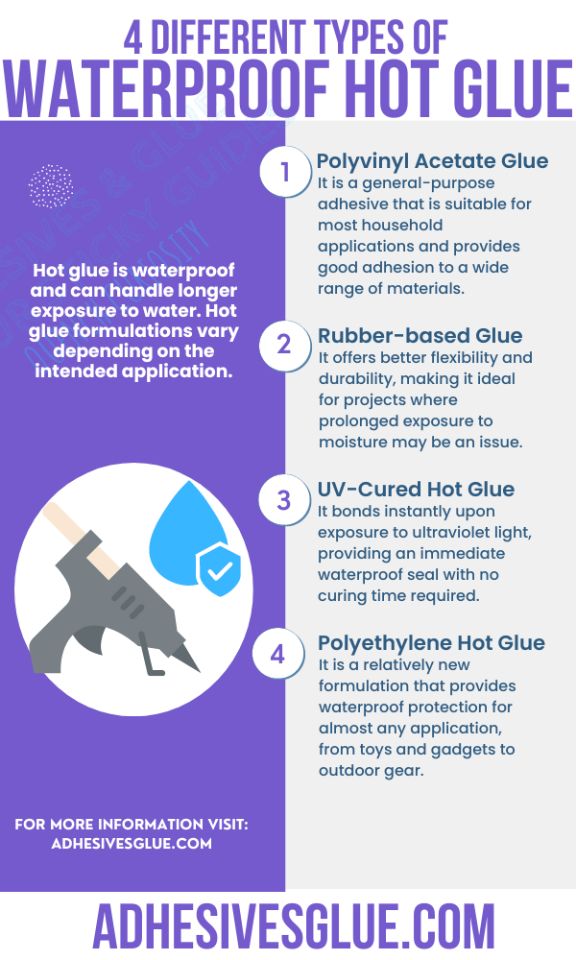Hot glue is most often used for crafting and DIY projects, although it can also be used for industrial uses such as fabricating parts and components.
But, is hot glue waterproof?
In most cases, hot glue is waterproof and can handle longer exposure to water. However, some are not waterproof, but water-resistant, depending on the material they are made of. They can be made more resistant to water by using industrial-strength hot glue or all-purpose hot glue in conjunction with a sealant.
This article discusses tests that can determine whether hot glue is waterproof, the advantages and uses of hot glue.
Contents
Is Hot Glue Waterproof? 3 Easy Tests You Can Conduct
While most hot glues made of polymers are waterproof, it is best to conduct these tests to be sure that the adhesive will hold when exposed to water.
There are several tests that one can conduct on their own at home. These tests will help in determining whether or not a particular type of hot glue will be able to stand up against different levels of moisture and humidity without losing its integrity or effectiveness.
The best way to determine if hot glue is waterproof is to perform three tests; boiling, submerging, and temperature resistance testing.
1. Simple Boiling Test:
The Boiling test is the first step in seeing if hot glue is waterproof. An easy way to test the water resistance of hot glue is to conduct some simple tests to see how it holds up in various environments.
To perform the test, place a globule of hot glue into a pot and slowly bring it up to boiling temperatures.
While the hot glue doesn’t need to reach its melting point for this experiment, it can determine how long it takes for the glue to lose its integrity and start coming apart when exposed to high heat.
2. Submersion Test:
Another practical test for water resistance is submerging the glue underwater and letting it soak for an extended period. If the glue remains intact after submerging, you can be confident that it has enough water resistance for your project.
3. Temperature Resistance Test:
Temperature resistance testing is also useful in determining if a particular type of hot glue will work well in moist environments.
This can be done by applying a small amount of the glue onto a piece of cardboard or scrap paper and then placing it into an ice container or any other environment that mimics the type of temperature, that your project will be exposed to.
If the joint remains intact after exposure, then there would not be an issue with water breaking down your adhesive bonds during use.
3 Factors That Affect Hot Glue’s Waterproof Abilities:
1. Application Process:
The application process is an important factor to consider when using hot glue. Proper application of the adhesive is critical to ensure that it adheres properly and effectively seals against moisture.
Before applying the glue, the area must be cleaned and dried thoroughly, and the adhesive should be applied evenly for it to create a waterproof bond.
2. Temperature:
Hot glue works best when used between 70 and 85 degrees Fahrenheit, as lower temperatures can lead to poor adhesion, while higher temperatures can damage components or cause them to become brittle.
Extreme temperatures can also affect the strength of the adhesive, so it’s important to keep this in mind when using hot glue outdoors on items that may be exposed to extreme weather conditions.
3. Formulation:
Different formulations of hot glue provide different levels of water resistance. Some glues are formulated with rubber for added flexibility, which allows them to better withstand temperature fluctuations and moisture exposure without degrading over time.
It’s important to select the right formulation for the specific application to ensure maximum performance.

4 Uses of Waterproof Hot Glue:
1. Aquariums:
Hot glue can be used for sealing aquarium parts and decorations, as it is resistant to water to keep the seals secure and prevent leaks. The adhesive must be applied carefully and evenly to create an effective water-tight bond.
2. Outdoor Furniture:
Waterproof hot glue can be used for outdoor projects where it can be exposed to moisture. It is often used to construct garden furniture such as chairs and tables, where it needs to remain firmly fixed despite exposure to rain or other moisture. As such, waterproof hot glue should be chosen to guarantee the longevity of the pieces.
3. Bathrooms:
Installing fixtures such as sinks, showers, and tubs typically requires waterproof hot glue. It makes sure that surfaces remain securely bonded while also protecting them from prolonged exposure to water.
It’s important not only for strength but also for hygiene, as wet surfaces can quickly become infested with mold.
4. Roofing:
Gaps around tiles or shingles need a durable adhesive like hot glue for them to resist wind and weather conditions over long periods without degrading.
The adhesive should be waterproof for it to protect the roof from moisture intrusion caused by rainfall or humidity levels over time.

4 Types of Waterproof Hot Glue:
Hot glue formulations vary depending on the intended application. Common formulations include polyvinyl acetate (PVA), rubber-based, UV-cured, and polyethylene (PE) hot glues.
1. Polyvinyl Acetate (PVA) Hot Glue:
Polyvinyl Acetate (PVA) hot glue is a general-purpose adhesive that is suitable for most household applications and provides good adhesion to a wide range of materials.
However, it is not waterproof and will not provide reliable water resistance over time.
2. Rubber-based Hot Glue:
Rubber-based hot glue offers better flexibility and durability than PVA. This makes it ideal for projects where temperature fluctuations or prolonged exposure to moisture may be an issue.
This formulation stands up better to extreme temperatures and holds its bond even when exposed to water or moisture in the air.
3. UV-Cured Hot Glue:
UV-Cured hot glue bonds instantly upon exposure to ultraviolet light, providing an immediate waterproof seal with no curing time required. This type of adhesive is best used for quick repairs or watertight seals on non-porous surfaces.
4. Polyethylene Hot Glue:
Finally, Polyethylene (PE) hot glue is a relatively new formulation that provides waterproof protection for almost any application, from toys and gadgets to outdoor gear.
It has strong bonding capabilities but remains flexible enough to move with the material over time without deteriorating due to exposure to moisture or extreme temperatures.
Different formulations of hot glue have different levels of water resistance. Rubber-based glues provide better flexibility and durability than PVA hot glues and UV-cured offer instant waterproof seals on non-porous surfaces with no curing time required.
The right choice between PVA, rubber-based, UV-cured, or polyethylene (PE) hot glues depends on the specific application and environmental factors such as humidity and temperature.
3 Advantages of Waterproof Hot Glue:
Hot glue is a versatile and convenient adhesive material that can be used for a wide variety of projects. It is a water-resistant glue that is ideal for indoor and outdoor projects that involve moisture.
Here are some of the main benefits of using waterproof hot glue:
1. Durability:
Waterproof hot glue offers superior durability compared to ordinary adhesives. This makes it an excellent choice for long-term projects exposed to the elements.
Its waterproof properties prevent the adhesive from being weakened by water or moisture, ensuring that your project will last for years without any issues.
2. Flexibility:
Another great advantage of waterproof hot glue is its flexibility. Unlike ordinary adhesives that tend to be brittle and crack when bent, waterproof hot glue stays strong even after being flexed or stretched out.
This makes it perfect for holding together items with irregular shapes, such as pipes or hoses, which require more flexibility than regular adhesives can provide.
3. Cost-Effective:
Waterproof hot glue is also much cheaper than alternative adhesives on the market, which makes it a cost-effective option for those looking to get their projects done in a budget-friendly manner.
Furthermore, since you only need a small amount each time you use it, buying this type of adhesive will save you money in the long run.
Conclusion:
Hot glue’s resistance to water and moisture makes it an ideal choice for indoor and outdoor projects that involve moisture. It glue provides better durability and flexibility compared to other types of adhesives on the market today.
Its cost-effectiveness also makes it a better option for those looking to complete their projects on a budget.

I fell in love with crafts & fixing things when I was 11 years old – after discovering the world of blogging, I am combining my passions to present the world with well-researched guides & reviews about everything related to adhesives & glue.